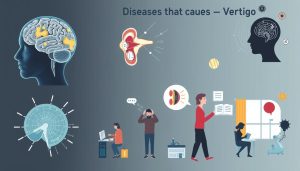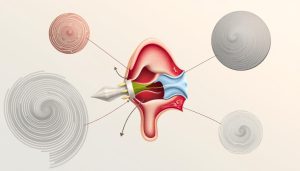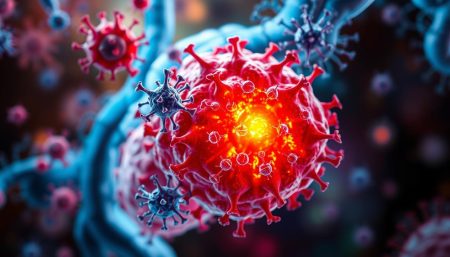Addison’s disease is a chronic endocrine disorder that affects hormone regulation in the body. It mainly deals with a lack of cortisol, a hormone made by the adrenal glands. Early detection and treatment are key to managing this condition and living a healthy life. People with Addison’s disease face many symptoms. If not treated, these symptoms can lead to serious problems. By understanding Addison’s disease, patients and doctors can work together to manage the condition and avoid emergencies.
To really get what chronic condition means, it’s important to know the signs and seek medical help early. For more on this, including how to avoid Addison’s disease crises, read our detailed guide on this important endocrine disorder.
What is Addison’s Disease?
Addison’s Disease is a condition where the adrenal glands don’t make enough hormones, like cortisol. This can really affect how our bodies work and our overall health. It’s important to know the difference between primary and secondary forms to get the right treatment.
The Basics of Adrenal Insufficiency
Adrenal insufficiency happens when the adrenal glands can’t make enough steroid hormones. The main hormone, cortisol, helps with metabolism, blood pressure, and fighting inflammation. Without enough cortisol, we can feel really sick.
Categorizing Addison’s Disease: Primary vs Secondary
Primary adrenal insufficiency is when the adrenal glands get damaged, often by autoimmune diseases. Secondary adrenal insufficiency is when the pituitary gland doesn’t make enough ACTH. This hormone is needed to tell the adrenal glands to make cortisol.
Knowing the difference helps doctors find the right treatment for each person. It’s all about fixing the specific problem in each case.
| Adrenal Insufficiency Type | Caused By | Impact on Hormone Levels |
|---|---|---|
| Primary | Autoimmune damage, infections | Low cortisol, often low aldosterone |
| Secondary | Inadequate ACTH production | Low cortisol, normal aldosterone |
Managing Addison’s Disease well means understanding the different types of adrenal insufficiency. This knowledge helps doctors choose the best treatment for each patient.
Early Warning Signs of Addison’s Disease
Spotting the early warning signs of Addison’s disease is key to better health. This condition, where the adrenal glands don’t work right, often starts with symptoms that seem like stress or too much work. Knowing the early signs and looking for adrenal insufficiency signs can help catch the disease early. This leads to better treatment and a better chance of managing the condition.

The first signs of Addison’s disease are often small. They include feeling very tired, muscles that feel weak, and changes in the skin. These signs can sneak up on you and might not be noticed until the disease has gotten worse. But catching them early is very important to stop the disease from getting worse.
- Fatigue even after adequate rest
- Muscle weakness that disrupts daily activities
- Substantial weight loss without a clear reason
- Low blood pressure leading to fainting spells
- Hyperpigmentation or unusual darkening of the skin
These adrenal insufficiency signs and symptoms can look like many other health issues. So, it’s very important to catch them early. Doctors should think about Addison’s disease if these signs don’t go away or get worse.
| Symptom | Commonality | Related to Addison’s Disease |
|---|---|---|
| Fatigue | Common in general population | Yes – Often overlooked as stress-related |
| Muscle weakness | Less common | Yes – Major sign often occurring early in the disease |
| Skin Darkening (Hyperpigmentation) | Uncommon | Yes – A distinct sign notable in sun-exposed areas |
| Weight loss | Varies | Yes – Occurs despite normal eating habits |
| Low blood pressure | Common in elderly | Yes – Can lead to dizziness and fainting |
Spotting these early signs and telling patients to see a doctor is very important. It can save lives. Making people aware and teaching them about these signs is key to catching the disease early.
Unveiling the Symptoms of Addison’s Disease
Addison’s disease is when the adrenal glands don’t make enough hormones. This affects both physical and mental health. We’ll look at cortisol deficiency, psychological effects, and symptoms in children.
Physical Manifestations of Cortisol Deficiency
Not having enough cortisol leads to symptoms like extreme tiredness and muscle weakness. People might also lose weight without trying. Skin can get darker in some spots, and blood pressure drops when standing up.
Psychological Impact of Hormonal Imbalance
Psychologically, Addison’s disease can cause mood swings and depression. Managing this condition can make these feelings worse. It’s important to treat both body and mind.
Unique Symptoms in Children and Adults
In kids, symptoms can be hard to spot. They might grow slower and crave salty foods. This is different from adults.
Adults and children show symptoms in their own ways. Each group needs a special approach to diagnosis and treatment.
| Age Group | Common Symptoms | Unique Symptoms |
|---|---|---|
| Children | Weight loss, Salt cravings | Delayed growth, Frequent fatigue |
| Adults | Hyperpigmentation, Orthostatic hypotension | Mood swings, Muscle weakness |
To learn more about adrenal insufficiency and managing symptoms, visit this detailed guide on Addison’s disease.
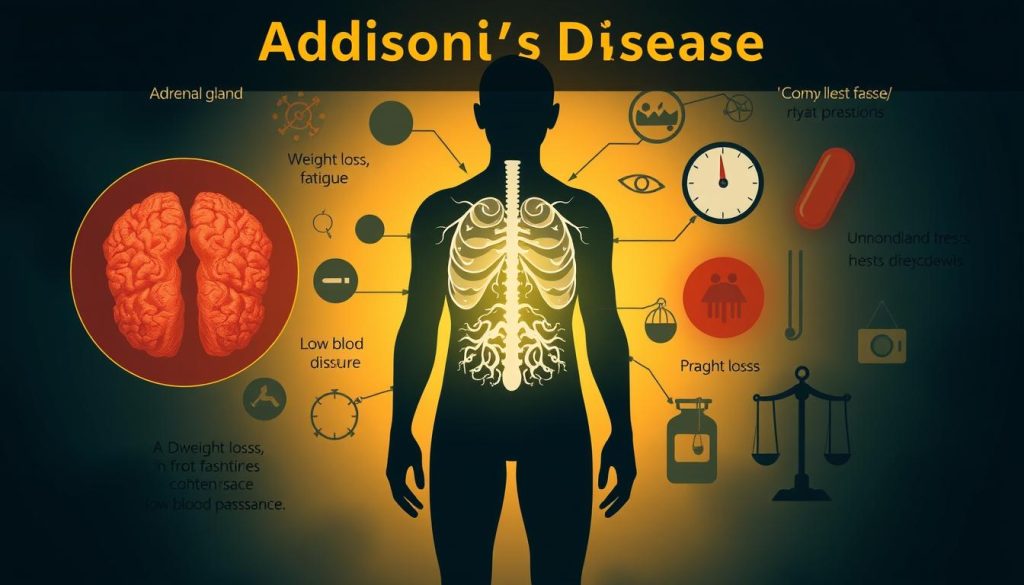
Diagnosing Addison’s Disease
The journey to a correct Addison’s disease diagnosis starts with tests for adrenal insufficiency. These tests are based on symptoms and a doctor’s suspicion. They use blood tests and imaging to confirm the disease and see how severe it is.
First, blood tests check for electrolyte imbalances. These are common in Addison’s Disease. Here’s a quick overview of the key steps:
- Blood tests: These check sodium, potassium, and cortisol levels. They often show signs of Addison’s disease.
- ACTH Stimulation Test: This test measures cortisol levels before and after an ACTH injection. It shows how well the adrenal glands work.
- Imaging studies: CT or MRI scans look at the adrenal glands. They help find any problems with their size or shape.
These steps are vital for confirming Addison’s disease and differentiating it from other conditions.
| Test | Purpose | Indicator of Addison’s Disease |
|---|---|---|
| Blood Test | Electrolyte balance | Low sodium, high potassium |
| ACTH Stimulation Test | Adrenal response | Poor or no increase in cortisol |
| Imaging (CT/MRI) | Assess adrenal gland size/shape | Atrophy or other abnormalities |
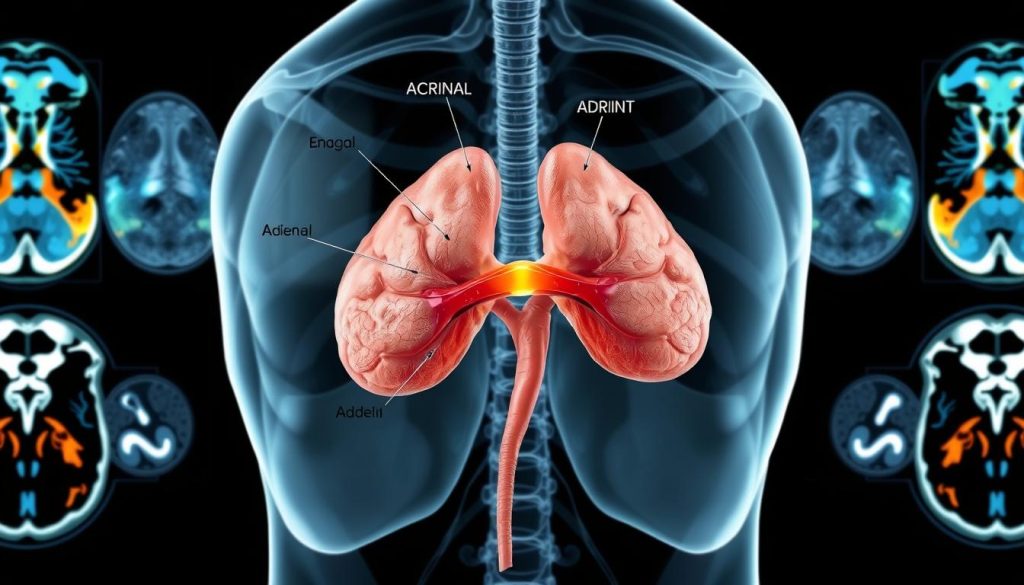
By focusing on these tests, doctors can accurately diagnose Addison’s disease. This leads to timely and effective treatment plans. The importance of adrenal insufficiency testing cannot be overstated. It is key to managing this chronic condition.
The Role of Autoimmunity in Addison’s Disease
Autoimmune disorders, like Addison’s disease, happen when the body’s immune system attacks its own tissues. In Addison’s disease, the immune system targets the adrenal glands. This makes it hard for the glands to make important hormones like cortisol and aldosterone. We will look at how certain Addison’s disease triggers tied to autoimmunity can cause this condition. We will also see how it connects to other autoimmune diseases.
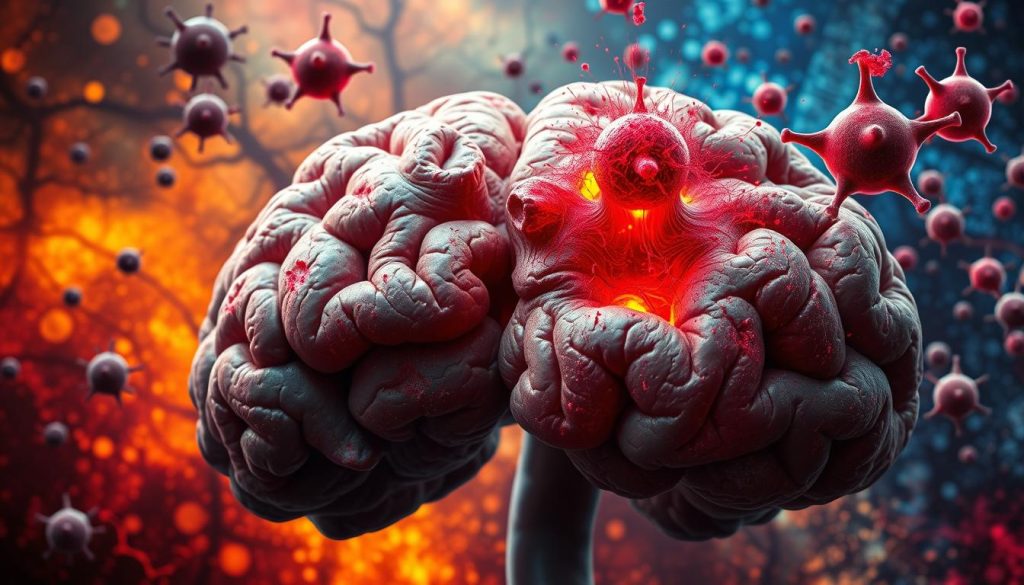
Understanding Autoimmune Triggers
Finding out what triggers autoimmune responses is key to understanding Addison’s disease. Experts think that environmental factors can start this autoimmune reaction in people who are genetically predisposed. These triggers include infections, stress, and reactions to certain medicines. These factors can start or make the autoimmune process worse, leading to damage of the adrenal tissues.
Relation to Other Autoimmune Disorders
Autoimmune adrenal insufficiency often goes hand in hand with other autoimmune diseases. This includes type 1 diabetes and autoimmune thyroid disease. Together, they form a condition called Autoimmune Polyendocrine Syndrome (APS). In APS, the immune system attacks multiple glands. Knowing how these diseases are connected is important for treating and managing Addison’s disease. It also helps in research into the common causes and risk factors.
- Thyroid Disease: Often happens with Addison’s disease, affecting hormone levels.
- Type 1 Diabetes: Commonly found with Addison’s disease, affecting blood sugar levels.
- Pernicious Anemia: Linked to autoimmune diseases that affect the stomach and vitamin B12 absorption.
As research into autoimmune diseases grows, understanding and managing Addison’s disease triggers is more important. This knowledge helps in treating the disease and preventing it in those at risk. It also helps in managing other autoimmune conditions.
The Addison’s Disease Connection to Other Endocrine Disorders
Addison’s disease often doesn’t stand alone. It often links with other endocrine disorders, creating a pattern of polyendocrine deficiency syndromes. This connection affects how we diagnose and manage these conditions.
It’s key to understand the shared pathways and common factors among these disorders. For example, Addison’s disease, which involves low adrenal hormone levels, might also be present with Type 1 Diabetes Mellitus or Hashimoto’s thyroiditis. Knowing these connections helps endocrinologists better monitor and manage patients.
- Thyroid disorders: Often found with Addison’s disease due to shared autoimmune causes.
- Type 1 diabetes: Commonly seen together, requiring careful blood sugar monitoring in Addison’s disease patients.
- Hypoparathyroidism: Though less common, it’s important for a complete hormonal check-up.
Dealing with these conditions requires a team effort from healthcare professionals. By addressing Addison’s disease comorbidities, we can improve diagnosis and treatment. This approach leads to better patient outcomes by tailoring care to each individual’s needs.
Comprehensive Treatment Options for Addison’s Disease
Managing Addison’s disease well needs a mix of treatments. This includes hormone therapy, lifestyle changes, and regular check-ups. Knowing and using these methods can greatly improve life for those with the disease.
Hormone Replacement Therapy: A Cornerstone Treatment
Hormone therapy is key to replace missing hormones. It usually involves glucocorticoids like hydrocortisone and mineralocorticoids like fludrocortisone. These help with metabolism, immune function, blood pressure, and balance of electrolytes.
Lifestyle Modifications and Addison’s Disease Management
Making lifestyle changes helps manage Addison’s disease. Stress management, like mindfulness and yoga, is important. Also, eating enough sodium is needed, more so when sweating a lot.
Long-term Monitoring and Adjustment of Treatment Plans
Regular check-ups are vital for Addison’s disease. Doctors keep hormone levels right and adjust treatments as needed. Life changes, like pregnancy, may mean changes in medication, showing the need for ongoing care.
Emergencies: Recognizing and Managing an Adrenal Crisis
An adrenal crisis is a serious health emergency that needs quick action. It’s a critical phase of Addison’s disease that can be deadly if not treated fast. It’s vital to know the signs and how to handle an acute adrenal failure to keep patients safe.
Symptoms of an adrenal crisis include severe stomach pain, deep weakness, extreme tiredness, low blood pressure, and sometimes loss of consciousness. These symptoms need quick medical help to avoid more problems and keep the patient stable.
Managing an adrenal crisis often means giving hydrocortisone injections quickly. It’s key for patients and their caregivers to have emergency hydrocortisone ready. They should also know how to use it.
- Call for emergency medical help immediately if symptoms of an adrenal crisis show up.
- Give an emergency injection of hydrocortisone if you have it.
- Make sure the patient is lying down and, if you can, raise their legs to help blood flow.
- Keep the patient warm and comfy until medical help gets there.
Being ready is important in handling an adrenal crisis well. Patients with Addison’s disease should wear medical alert tags. They should also tell their friends, family, and coworkers about their condition and what to do in an emergency.
Knowing these important steps can greatly impact the outcome of an Addison’s disease emergency. It could save lives during an acute adrenal failure episode.
Addison’s Disease in Children and Adolescents
Diagnosing and treating Addison’s disease in kids and teens is tough. It’s important to manage it well so it doesn’t slow down their growth and development.
Diagnostic Challenges in the Younger Population
Finding out if a child has Addison’s disease can be hard. Symptoms can look like other childhood illnesses. In teens, it might seem like normal puberty changes.
Signs like tiredness and belly pain are often missed. They’re thought to be from less serious problems.
Treating Addison’s Disease While Supporting Growth and Development
Doctors treat Addison’s in kids by giving them the hormones they need. They also keep an eye on how the child is growing. Hormones are important for growth, so doctors have to get it just right.
- Ensuring adequate daily cortisol levels to manage stress and reduce the risk of adrenal crises.
- Customizing treatment plans based on growth and puberty stages, ensuring that hormonal interventions align with developmental needs.
- Regular monitoring of growth metrics and developmental milestones to adjust treatment as needed.
It’s key to involve the family in the treatment plan. A supportive family helps kids stick to their treatment and know about possible problems.
Nutritional Considerations and Support for Addison’s Disease Patients
Managing Addison’s disease is more than just taking medicine. It also means getting the right nutrition to keep your health and hormones in balance. This includes following a special diet that helps with sodium and potassium levels.
The Importance of Sodium and Potassium Balance
For those with Addison’s disease, it’s key to keep sodium and potassium levels right. This balance is important for your adrenal health and heart function. Doctors often tell patients to eat more salt, like in pickles or pretzels, when they’re active or it’s hot outside.
Dietary Adjustments and Supplementation
An effective diet for Addison’s disease might include more salt and enough potassium. Foods high in sodium, like cheese or pretzels, can help. On the other hand, eating bananas, oranges, and leafy greens can help keep potassium levels up.
- Eating more salty foods to make up for low aldosterone levels.
- Keeping potassium intake balanced to avoid too much potassium.
- Watching how many calories you eat to keep your energy up.
It’s also important to avoid foods and drinks that could make symptoms worse or affect your medicine.
Following these dietary tips can help manage Addison’s disease. It’s also important to keep talking to your healthcare team to make sure you’re getting the right nutrition and medicine.
Addison’s Disease Research and Future Directions
The field of Addison’s disease research is always evolving. Scientists are working hard to find new ways to treat adrenal insufficiency. They are looking into genetic engineering, new hormone therapies, and better diagnostic tools.
New studies are focusing on making hormone replacement therapies better. They aim to match the body’s natural rhythms more closely. This could greatly improve patients’ lives by reducing side effects.
Immunotherapy is also being explored. It could help control the immune system’s attack in Addison’s disease. This could be a big step forward in treating the condition.
- Investigation into new delivery systems for corticosteroids
- Research on genetic markers that predict the disease
- Development of next-generation diagnostic tests
| Research Area | Objective | Expected Impact |
|---|---|---|
| Genetic Therapies | Modify genes to prevent autoimmunity. | Reduce incidence of Addison’s in high-risk populations. |
| Novel Hormone Therapies | Improve hormone absorption and timing. | Better symptom control and reduced complications. |
| Immunomodulators | Target and modulate immune response. | Decrease dependency on lifelong corticosteroids. |
The future of adrenal insufficiency therapy is looking bright. The goal is to make treatments more personalized and less invasive. This will greatly improve the lives of those with this condition. Ongoing advancements in treatment are key to achieving this goal.
Living with Addison’s Disease: Patient Stories and Support Networks
People living with Addison’s disease face many challenges every day. Their stories show the bravery and strength needed to manage this condition. Support networks and online communities play a big role in helping them.
Personal Experiences and Managing Daily Life
Life with Addison’s disease is different for everyone. These stories help us understand the physical and emotional effects of the disease. They show how people adjust their routines and manage their medicine.
The Role of Support Groups and Online Communities
Support groups and online communities are very important for many. They offer emotional support and practical advice. These places are where people share their experiences and learn from each other.
Here are some real-life examples of how these communities help:
| Experience | Impact |
|---|---|
| Sharing daily management tips | Improves treatment adherence and lifestyle adjustments |
| Emotional support from peers | Reduces feelings of isolation and anxiety |
| Access to updated medical information | Keeps members informed about the latest treatment options |
| Planning and participating in meet-ups | Enhances real-world bonds and community cohesion |
Understanding Addison’s Disease in Canines: A Comparative Look
Addison’s disease in dogs is a key area in comparative endocrinology. It shows how this condition affects dogs and humans in similar yet different ways. Dogs with Addison’s disease lack adrenal hormones, leading to symptoms like tiredness and vomiting.
These symptoms can be mild at first but become serious if not treated. Like humans, dogs with Addison’s disease struggle with stress. But, their diagnosis and treatment are adjusted for their unique needs.
Treatment for dogs with Addison’s disease often includes hormone replacement. They may get fludrocortisone or DOCP to replace missing hormones. The dosage and timing are carefully chosen to match their metabolism. This is important because dogs can’t tell us how they feel.
For more information, check out a detailed resource on managing and treating Addison’s Disease in dogs.
Studying Addison’s disease through comparative endocrinology deepens our understanding of how diseases can affect different species. Managing Addison’s disease in dogs is complex and requires ongoing care. Dog owners must watch for symptoms and work closely with vets.
Regular vet visits and sticking to treatment plans are key to managing the disease long-term.
FAQ
Q: What are the common symptoms of Addison’s disease?
A: Symptoms include feeling very tired, losing weight, and muscle weakness. Low blood pressure and skin color changes are also common. People with Addison’s often crave salty foods.
Q: How is Addison’s disease diagnosed?
A: Doctors use a few methods to diagnose it. They look at symptoms, do blood tests, and use imaging studies. These help find out if the adrenal glands are working right.
Q: What is the difference between primary adrenal insufficiency and secondary adrenal insufficiency?
A: Primary adrenal insufficiency, or Addison’s disease, happens when the adrenal glands are damaged. Secondary adrenal insufficiency is when the pituitary gland doesn’t make enough ACTH. This stops the adrenal glands from making cortisol.
Q: Can Addison’s disease be effectively treated?
A: Yes, it can be managed well. There’s no cure, but hormone replacement therapy helps. This therapy replaces cortisol and sometimes aldosterone.
Q: What triggers an adrenal crisis in people with Addison’s disease?
A: An adrenal crisis can be caused by stress, injury, or infection. It can also happen if someone with Addison’s disease forgets to take their medication.
Q: Are there any lifestyle modifications necessary for someone with Addison’s disease?
A: Yes, there are important lifestyle changes. Eating more salt, staying hydrated, and managing stress are key. Wearing a medical alert bracelet is also important.
Q: What role does autoimmunity play in Addison’s disease?
A: Autoimmunity is a big part of Addison’s disease. The immune system attacks and destroys the adrenal glands. This leads to a lack of cortisol and aldosterone.
Q: How does Addison’s disease affect children and adolescents differently from adults?
A: In kids and teens, Addison’s disease can affect growth and puberty. Symptoms might be hard to diagnose, making it challenging to find the right treatment.
Q: What nutritional considerations are important for people with Addison’s disease?
A: It’s vital to balance sodium and potassium intake. Patients may need more sodium, like during exercise or in hot weather.
Q: Are there support networks for individuals with Addison’s disease?
A: Yes, there are many support groups and online communities. They offer encouragement, share experiences, and provide helpful advice.
Q: What advancements are being made in Addison’s disease research?
A: Research is ongoing to improve diagnosis and treatment. Scientists are working on new hormone replacement therapies and understanding the genetic causes of the disease.
Q: Can animals, such as dogs, have Addison’s disease?
A: Yes, dogs can get Addison’s disease too. It affects them in similar ways to humans, requiring hormone replacement therapy and careful management.




